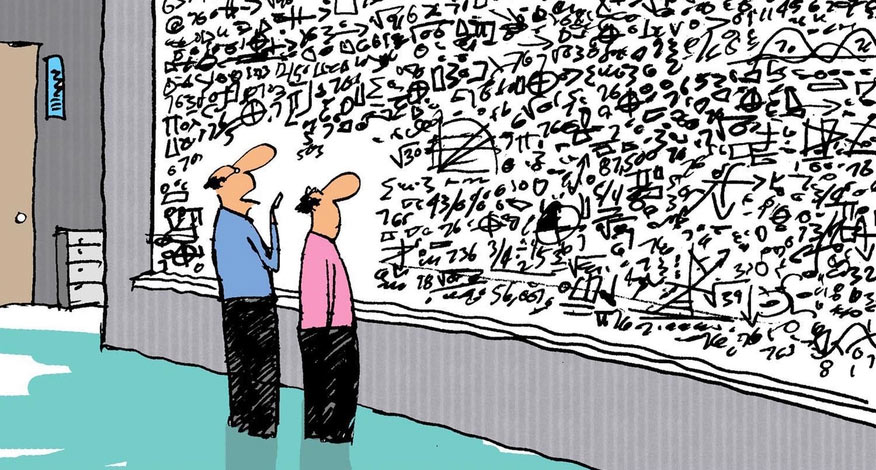 ^^ “And that, in a nutshell, is my marketing plan. Any questions?” – Don’t be this guy…
^^ “And that, in a nutshell, is my marketing plan. Any questions?” – Don’t be this guy…
As I’ve said, writing an effective email is no different – in principle – to writing a great book. You have a story to tell and a mission to evoke a certain response. But, in reality, it *feels* a million miles away.
“It all comes down to having a plan. With your book, it's all mapped out for you - and there are people to help. With email, you often feel that you're on your own - in uncharted waters. That's where a defined strategy gets results.”
And here’s the kicker…
Your readers don’t want to be “sold” to. Heck, YOU don’t want to be “sold” to, either. Not unless you actively want something and are looking for that solution.
Chances are, you’ve got ~50 different email campaigns hitting your inbox every day. I’ll wager every single one of them is actively trying to get you to buy something.
The problem is, this “brute force” approach has diminishing returns. And people get sick of it, fast.
There’s a place for “selling” – sure. But when it’s every. Single. Email…
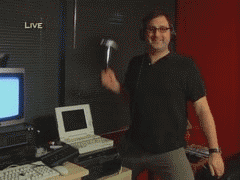
Nobody’s going to buy from you if they don’t trust you. Don’t like you. Don’t understand the VALUE you’re offering them.
Remember our heroes / heroines from the previous page?
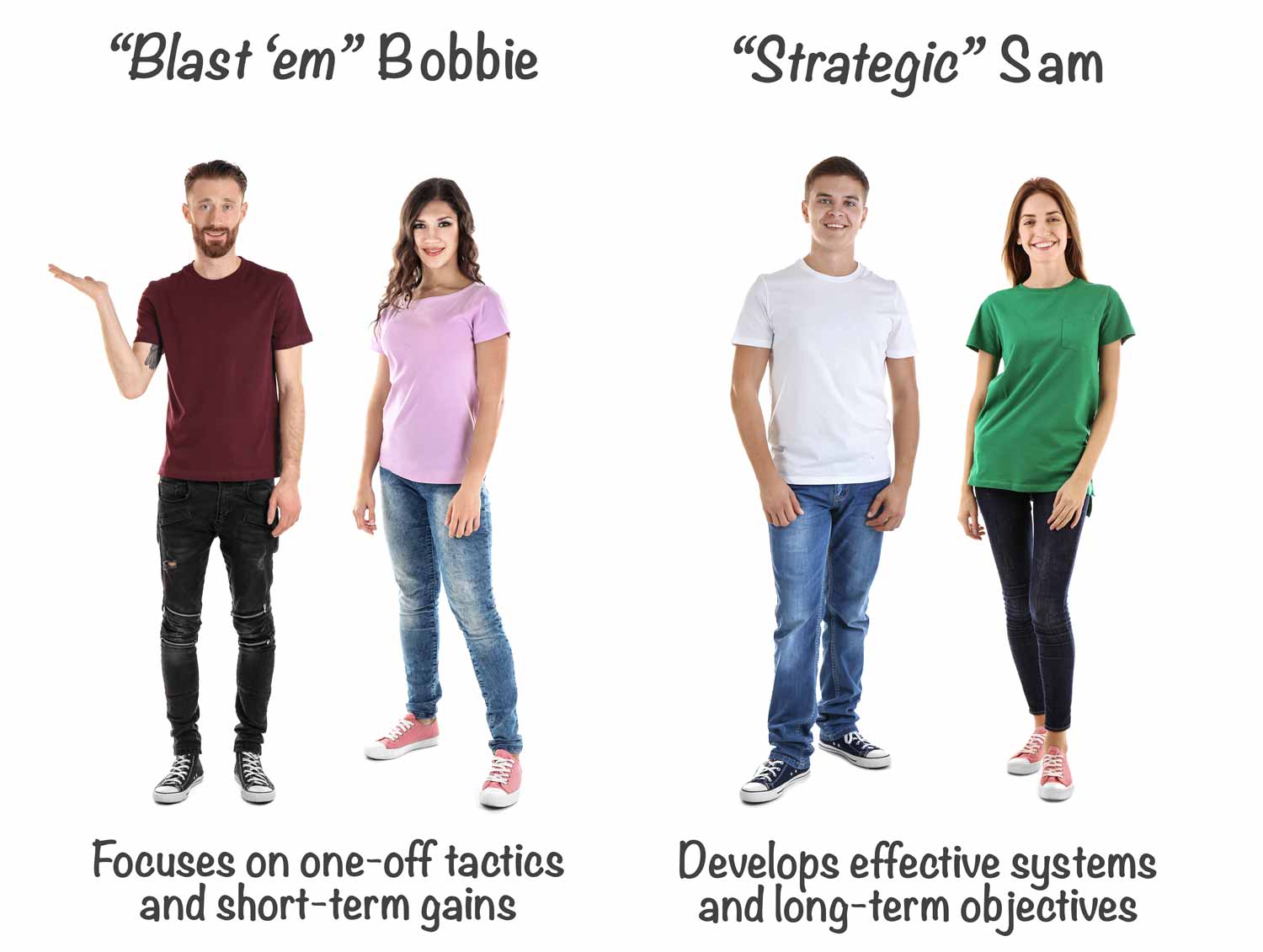
“Blast ’em Bobby” is focused on “what’s in it for me”. Sam focuses on “what’s in it for the reader”.
You can “sell” something and still offer immense value. In fact, that should go without saying.
A case in point – a very “meta” case in point – is this EMU series. We sell books, courses, software, and other products that help authors. A percentage of the people reading this series will want *more* help. We’ll provide a mechanism for those people to do so, if they choose, on a later page. If not, we’re still offering something valuable.
Whatever kind of books you write – fiction, non-fiction, thrillers, romance, how-to books, biographies, Amish science-fiction dinosaur adventures… it doesn’t matter. The first thing you need to understand is how what you’ve got (your books or other products) add value to your readers lives. What’s the benefit for THEM?
This is where a lot of authors struggle. They’ve assumed that “email marketing” means “selling stuff to strangers that they don’t want – all the time”. And that’s what many authors do. But it’s the wrong approach.
Your email marketing should be an extension of your books. You don’t relentlessly pitch your latest boxed-set in chapters one through forty, do you? No.
Instead, you provide readers with an exceptional EXPERIENCE. Build their trust, develop your brand, and prove your value.
I’ve received a lot of emails from authors saying “I get great responses when I send out emails about specific topics, but I feel really “icky” when I then try to sell something. What can I do?”
It’s a common problem. Here’s of couple of emails I read:
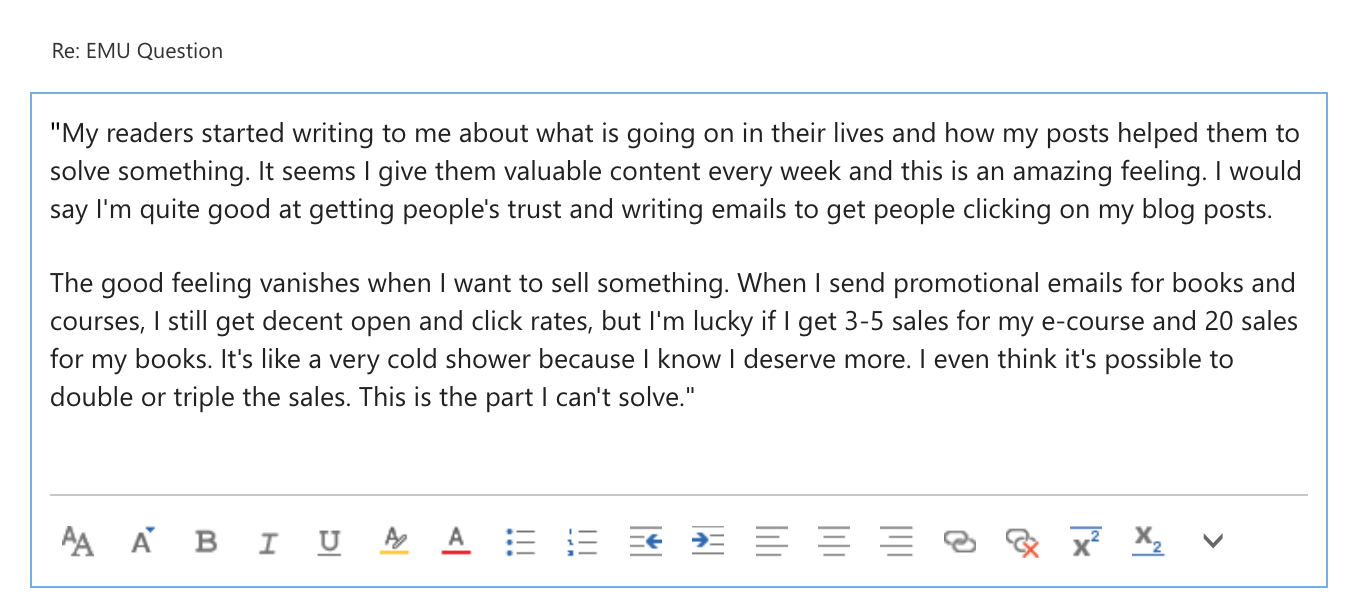
And…
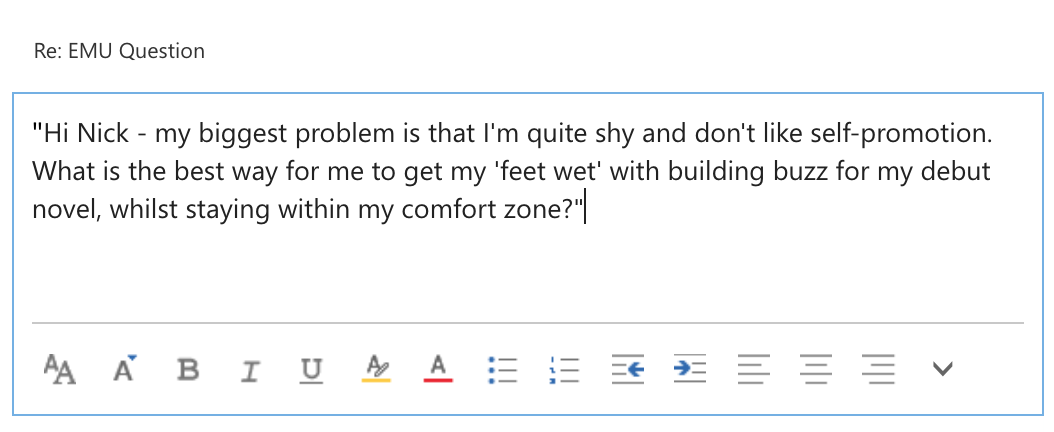 ^^ So many people struggle with the transition from “offering free stuff” to “asking for the sale”.
^^ So many people struggle with the transition from “offering free stuff” to “asking for the sale”.
I get it. Sending out “free stuff” is easy, and it feels good. You’re serving a LOT of people in a small way.
But you can also serve THE RIGHT people A LOT MORE when you have something valuable that people are willing to pay for. There’s a financial commitment from both sides.
(Note: “selling” isn’t about “tricking” people into buying something they don’t want. You’re just serving a selection of your audience in a more powerful way and letting THEM choose).
Take the “cookery” niche as an example. Sure, you can help a lot of people in a small way by sending out recipes and cooking tips. But how can you serve your readers who want MORE help?
A cooking class perhaps. More in-depth training. Maybe even a field trip to local restaurants.
Not everybody wants this, of course. Not everybody is ready to take things to the next level, and that’s fine. But those who are ready will look to you – as a trusted source – to provide that extra value.
That’s the polar opposite approach to “Blast ’em Bobby”. Consider this email I sent out – one of the first email broadcasts I ever made:
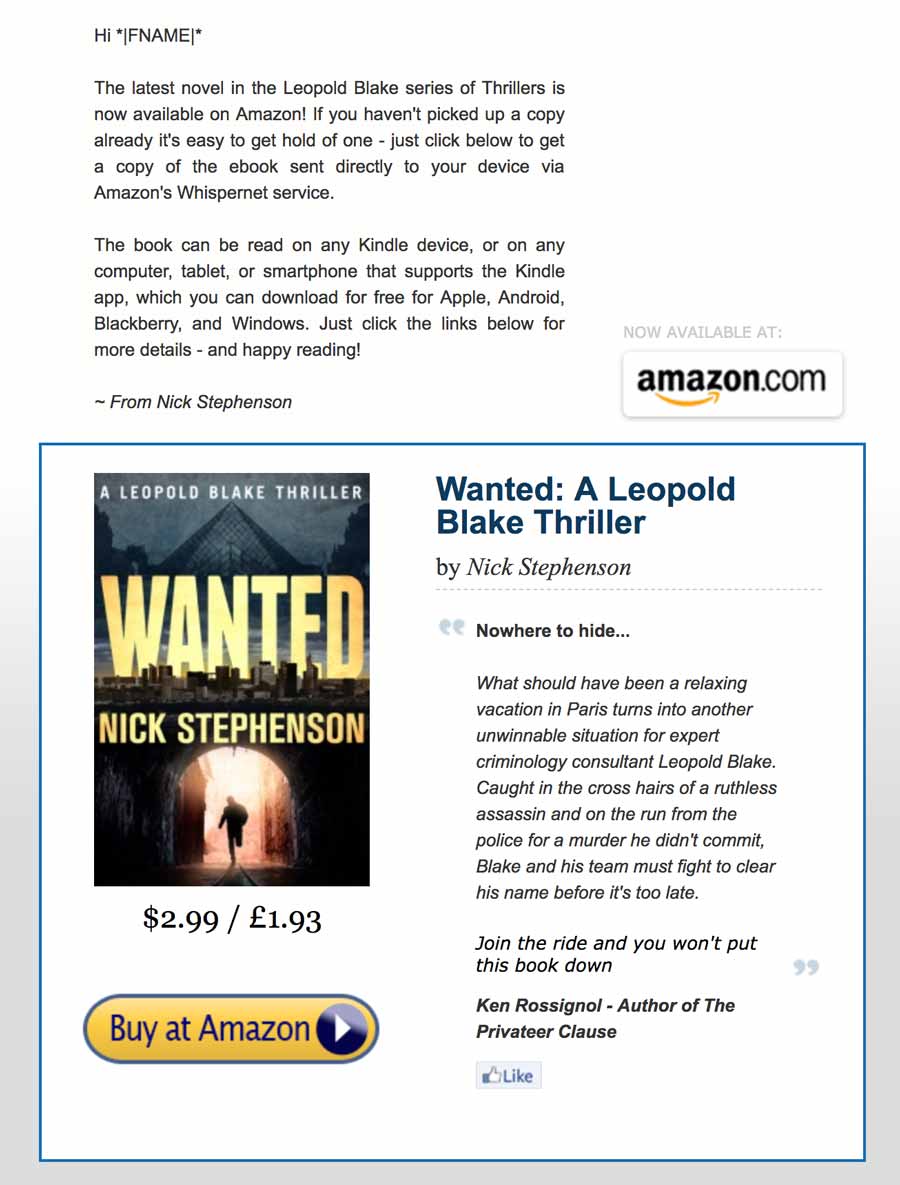 ^^ It’s hideous!!! And it didn’t work. At all.
^^ It’s hideous!!! And it didn’t work. At all.
Context: I’d spent 9 months building up an audience of around 1,000 readers. This was the first time I ever sent them anything about my books. Just this email, out of the blue, asking them to buy something.
As you can imagine, NOBODY bought it. And now we know why…
Your job is to build that trust and move people from where they are now (interested in the proverbial “recipe book”) to a place where you can give more value (the proverbial “cooking school”).
Same with fiction. You’ve offered a glimpse at what you do. For those who want to dive deeper down the rabbit hole, you need to have that option available. The *right people* want – and expect – that from you.
Note: In addition to your latest release or something from your backlist, you might offer ebook “boxed sets”, special editions, hard-covers, monthly subscriptions for short stories, Patreon deals… anything you know will add value for those who want it.
It all starts with building up that trust, excitement, and rapport. Just like you “build” towards a climax in your books – your emails should do the same. Emphasise that value and give your readers something incredible – long before you even think of asking for the sale.
This is the first piece of the puzzle. It will inform EVERYTHING you do next.
Before we dig in deeper, let’s recap quickly with your overall strategy – we’ll cover each of these “supporting tactics” throughout the EMU series:
Let’s talk specifics.
Out of the 1,100+ responses to the question “What’s your #1 struggle with author marketing”, almost every author I heard from has an issue with “coming up with content”.
This is the first pillar.
And, remember, this is all driven by the overarching principle we talked about above – offering VALUE first and foremost.
Let’s dig in.
In a world where paid advertising is getting more and more expensive (remember the days of $0.20 leads? They’re long gone…), social media just doesn’t do anything, and the author space is so saturated with spammy “buy my book” nonsense, I can understand why people feel it’s impossible to stand out from the crowd.
But through all these changes, two major principles have remained – (1) email is still the best way to reach large numbers of people, and (2) providing an exceptional reader experience is the surest way to grow a loyal audience.
Key point – I’d rather have 1,000 people on my email list who LOVE me than 20,000 random strangers I tricked into signing up for my email list on some spammy joint giveaway.
The “small and mighty” email list wins every time. A small, super-engaged list, will beat out a gargantuan list of “the mildly curious” where it counts.
This is the key principle to remember as we go through these action steps. As I said, it will inform everything you do.
(Stick a Post-it on your monitor or tattoo it on your hand – it’s important).
So let’s take the first two steps – defining your objective and “setting the tone”.
Exactly what you’re objective is going to be is entirely up to you. But common ones will be getting sales, getting reviews, getting reader replies, comments on a blog post, survey responses, etc.
Another example: one of our readers has issues getting readers to actually read the books they download:
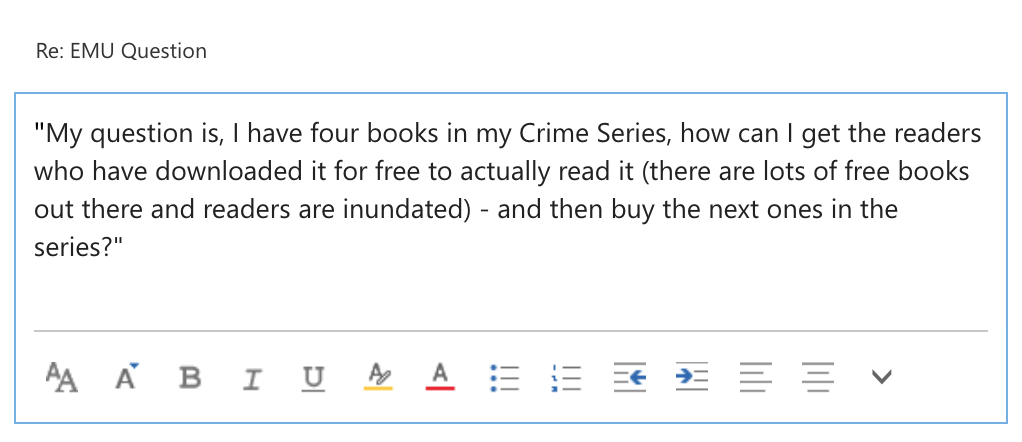 ^^ Your objective might not always be “get sales”, it might be something that helps your readers get to that point (like, actually reading the book you sent them)
^^ Your objective might not always be “get sales”, it might be something that helps your readers get to that point (like, actually reading the book you sent them)
The overall objective is up to you – the key thing is trying to stick to ONE objective at a time (and I know just how many authors *stuff* their emails with a dozen different calls-to-action… more on that later).
So, you’ll sit down and think: “Okay, I’m sending out this email because I want to get more reviews for my newest book.”
Or, “This email needs to drive as many sales as possible for this particular book over the next 48 hours”.
Fairly simple. But how do you achieve that objective?
That’s where the AIDA principle comes into play.
In a nutshell, your email needs to create one (or more) of the following “emotional” responses in your readers:
You might focus on one of those in each email. Or a few. Or all of them. And generally, during a launch or promotion, you’ll need to send several emails BEFORE your launch that cover all these points – before you even think about asking for the sale.
(Don’t worry, we’ll cover “launching” and “promotions” a little later).
The key part is making sure you know – before you sit down to write the email – what your objective is. The question you ask yourself:
Example – Jo has a new book launch coming up. She wants to get as many sales as possible during the first 3 days to help her book to the top of the charts.
Jo knows her main objective is to get as many sales as possible. So, a week before the launch starts, she schedules three emails to go out.
The first one is designed to grab attention – “Coming next week – sneak preview…”
The following emails build on Interest and Desire – “Here’s some back story to the book, a cover reveal… a sample chapter… details about launch-day bonuses…”
Then, on launch day, Jo sends out an email designed to drive conviction and action – “I’ve been telling you all about this last week… now’s the time to buy…”
That’s hugely simplified and we haven’t included one of the “key elements” yet (we’ll get into the nuts and bolts shortly), but the main point at this stage – the planning stage – is that each email has a defined purpose. Each has a set objective to meet (more sales) and each one is tailored to drive the response from her readers needed to meet that objective.
The main upshot is this – when you sit down to write an email, you should already know 80% or more of what you’re going to write. When you nail down the objective and the “purpose” of what you’re doing, it’s a lot easier.
But what about the burning question?
“What do I actually WRITE in my emails?”
Here’s where we dig a little deeper…
You’ll need to know how your main objective (reviews, sales, responses, getting someone to download a free book, etc) can be “framed”.
Meaning – it’s not always enough just to know what your objective is (eg – “make sales”, “get reviews”, etc). You need to know how to frame it in the right way to suit your audience, your own personal style, and to fit the action you actually want people to perform.
In other words, you need to define the “tone” you want to use. Or, more specifically, the “character or attitude” of your message.
Here’s how that works.
Your emails should generally fall into one of four categories:
Information – “this is happening now”, or “here’s what to do next”, or “here’s how to download your book”. Pretty much just laying out some instructions. A lot of these emails will be “transactional emails” or will form parts of other kinds of emails (where instructions are needed – eg the call to action in a sales email) and have a very narrow purpose.
Education – “here’s how to solve your problem”, “here’s an idea that might help you”, “here’s something you haven’t thought of before…”. Not just for the non-fiction folks. What’s the central “problem” your reader has? What are they trying to achieve or “get”? Here’s where you can help them with that (don’t know how this applies to fiction? Read this article).
Inspiration – “you can be part of this too,” or “here’s a glimpse of something awesome,” or “here’s how a change could affect you for the better”. Again, not just something for the non-fiction folks – look at what thriller author James Rollins does with his Twitter feeds:
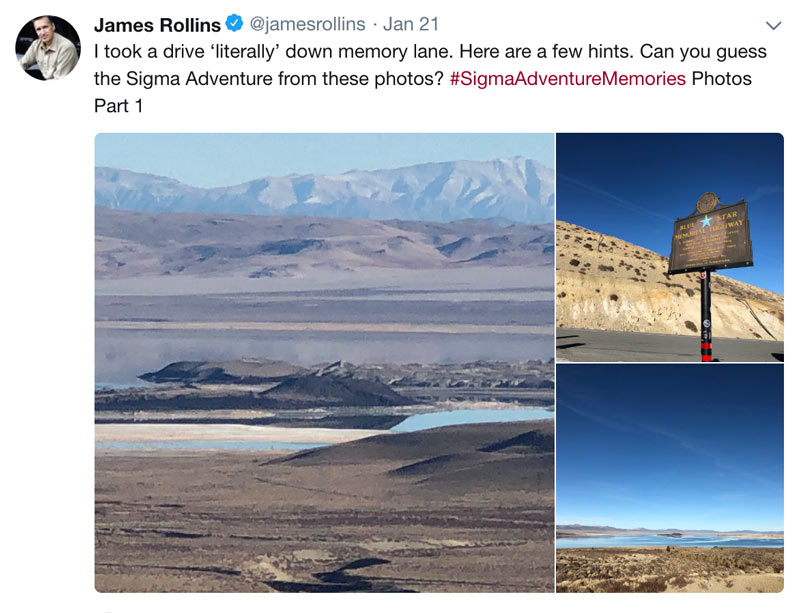 ^^ James is great at the “come and be part of my world” approach – see more here
^^ James is great at the “come and be part of my world” approach – see more here
Your readers – like James’ – value that “contact”. Regardless of how “boring” you think you might be, you wrote a book.
That instantly makes you more interesting than the 99.99% of people your readers will meet on a daily basis. Letting them into “your world” is a vital part of building that relationship.
Entertainment – “Here’s something you might enjoy”, or “Here’s your anti-dote to boredom today,” or, “Sit down with a cup of coffee and check THIS out…”
This is the “easy” part for fiction writers – or, at least, it should be. Consider what JK Rowling does on her website – it’s filled with quizzes, videos, commnutiy, and… well, it’s fun!
Or children’s author David Walliams – who uses challenges, competitions, and multi-media to get kids reading.
Or non-fiction author and journalist Lesley MM Blume who uses articles and slideshows to show her target audience a glimpse into the subject matter of her books.
While other authors are relentlessly pushing their latest release, these are some examples of authors putting their readers’ experiences first.
If you can do that with your website, you can do that with your emails. When your readers know you’re a source of value – that’s not hidden behind a paywall or dripped out in tiny pieces as a “bonus” for buying something – then you’re building massive equity with your audience.
And guess what? When “sales time” rolls around, that pays back in spades.
The tone you choose for your email will depend on the objective you’re trying to achieve.
And you’ll be amazed how easily and naturally the ideas and words will flow once you’ve nailed down your objective and your tone.
With that plan in place, you have a framework to support the next stage – coming up with your central “idea” or topic – which will inform the “story” you’re trying to tell.
(In other words, the starting point for “the words you’ll actually write”).
At this point, it’s all coming together. The beginnings of a plan are forming.
Let’s put some more meat on the bone.
How do you come up with a compelling “central idea”? How can you craft an effective email around that idea that’s going to meet the objectives you set out above?
We’ll cover that (in detail) on the next page with a structure to use for every single email you ever write.
Leave a comment below if so. And tell me – have you ever run an email campaign only to see it fall flat? Let me know, I’ll reply personally.
NB: you might need to be logged in to Facebook to see the comments section.
© Your First 10,000 Readers
Privacy | Terms | Disclaimer